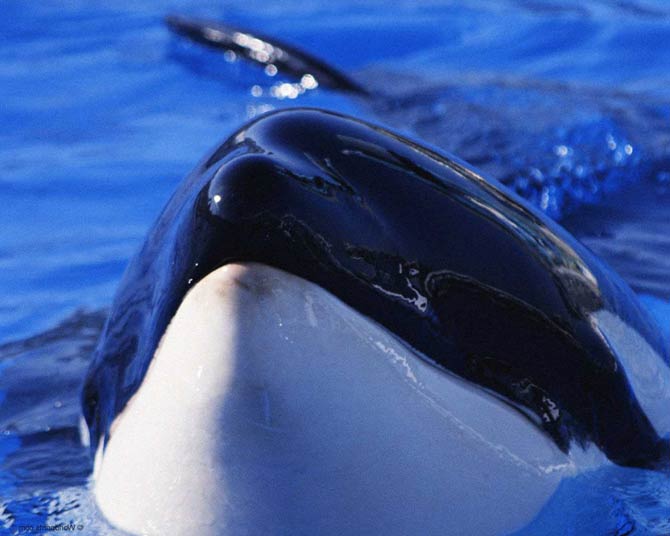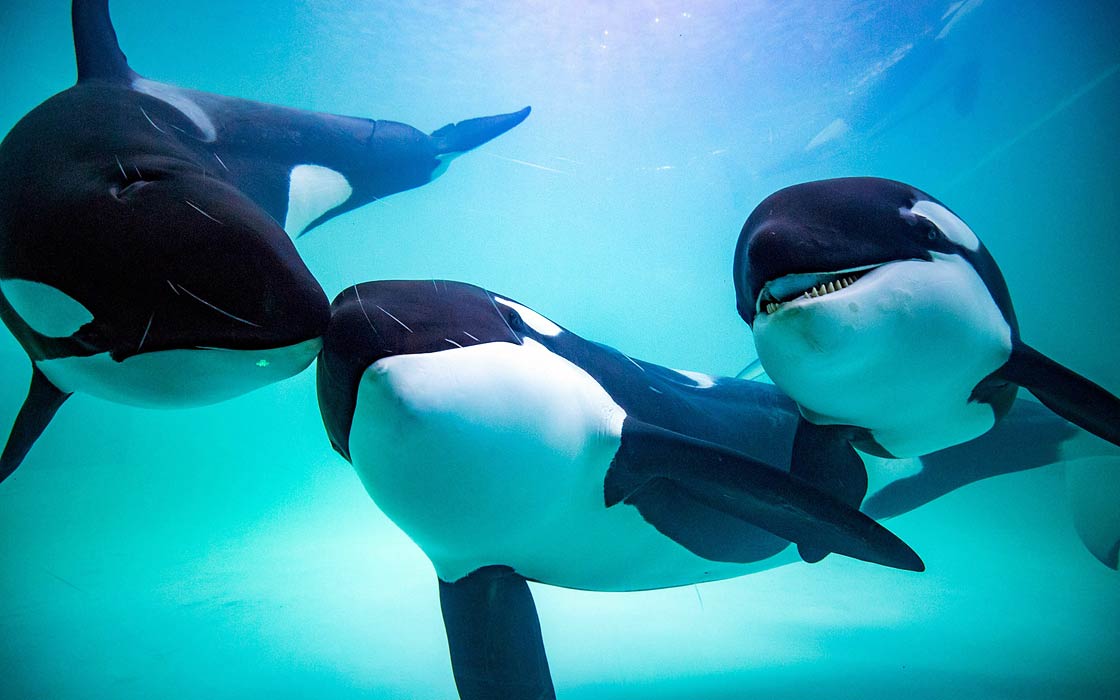The orca, killer whale (Orcinus orca)
Killer whales are the ocean’s largest and most dangerous predators. They have a characteristic black and white coloration, which makes them difficult to confuse with other species. Killer whales are found in all the world’s seas, but most abundantly in the waters of the Arctic and Antarctica.
Classification
- Kingdom: Animalia
- Phylum: Chordata
- Class: Mammalia
- Order: Artiodactyla
- Infraorder: Cetacea
- Family: Delphinidae
- Genus: Orcinus
- Species: Orcinus orca
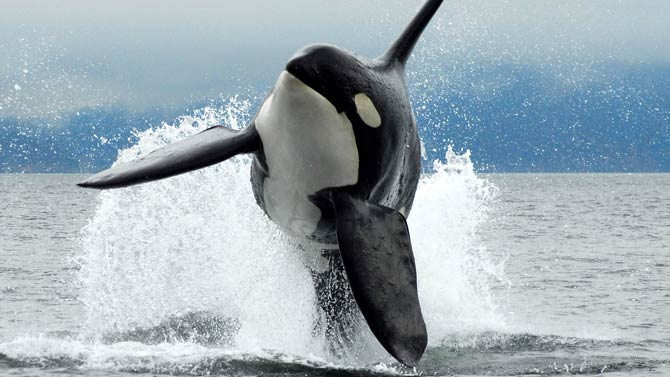
Orca – king of the oceans
Killer whales are the ocean’s largest and most dangerous predators. They have a characteristic black and white coloration, which makes them difficult to confuse with other species. Like dolphins, of which they are very close relatives, they use their sense of echolocation to navigate and find food.
Characteristic
The killer whale is the largest representative of dolphins, the only representative of the genus Orcinus. Black back, only a white spot behind the eye and a whitish spot behind the dorsal fin. The underside of the body is white, combined with a white patch on the side. The upper and lower dentition each have 10-12 pairs of pointed teeth slightly curved back.
Killer whales are social animals that have a complex population structure. The smallest unit is the mother line, a very close association of whales related to the mother. The worldwide orca population can be divided into different ecotypes, which differ in their physique, their vocalizations and their behavior. Whether the ecotypes represent individual species is the subject of scientific discussion – in particular, however, it is striking that members of different ecotypes do not cross. DNA analysis from 2010 suggest that several species and subspecies need to be distinguished.
At the global level, the killer whale is a generalist carnivore, which particularly prey on fish, marine mammals such as seals and occasionally other whales. In rare cases, adult baleen whales are also part of their prey. Local ecotypes mostly specialize in certain prey animals for which they have special hunting strategies. Orcas are top predators of the sea because they have no predators . They are known for coordinated hunting in groups.
The killer whale as a species is not considered endangered. The killer whale was largely spared from whaling . However, individual populations are threatened by pollution. The killer whale’s cultural significance ranges from traditional veneration by North American Indians to today’s controversial dolphinarium habits .
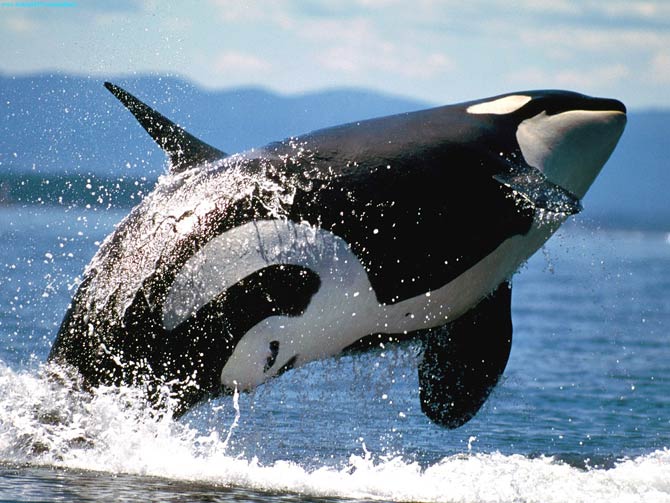
Diet
Killer whales have a very varied menu. They hunt fish of all sizes, from herring to salmon and sharks, and even large marine mammals such as dolphins and walruses. They also eat penguins, seals, octopuses and sea turtles. They often hunt in groups – then they can successfully attack the whales, trying to tear out their … tongue.
Size
Killer whales can reach a length of 10 meters (32.8 ft) and a weight of 9 tons (19,841 lb). Their size, jumping ability, speed and powerful jaws with strong sharp teeth combined with one of the most developed minds in the animal world mean that these marine mammals have no natural enemies. Even such ruthless and powerful killers as the great white shark and the tiger shark avoid them. Their main “enemy” are parasites, mainly internal.

Distribution
The killer whale is widespread worldwide, but is comparatively rare in tropical waters. The largest populations are found in higher latitudes, particularly in the North Pacific, North Atlantic and the Arctic Ocean. Most of the killer whale populations live relatively close to the coast for most of the time. In Europe, the killer whale is particularly common off Norway.
The species also lives in the waters around Greenland, Iceland, Jan Mayen, the Faroe Islands, the Bear Island, Franz Josef Land, Spitsbergen, Nowaja Semlja, the British Isles and the waters of the northern North Sea. The killer whale is rarer in the southern North Sea, for example before Sweden, Denmark, Germany and the Netherlands, and the same applies to the Baltic Sea. Killer whales are rarely sighted in the English Channel and off Western Europe. In the Mediterranean, specimens immigrating from the Atlantic are observed only in exceptional cases.
In the past, it has been observed with increasing frequency that, as global warming and the decline of the ice, killer whales are increasingly reaching arctic regions that they have previously avoided because of the ice, which poses a risk of injury to their back fin. This could cause the polar bear to contest the role of the top predator of the Arctic and also pose a potential threat to it, since the bears have to stay in the water for a long time if the ice surface disappears

Types
For the global classification, Forney & Wade (2007) propose three basic categories:
- Mammal-eaters: these killer whales hunting in particular other marine mammals such as seals and whales.
- Coastal fish-eaters: these populations usually stay near the coast and hunt mainly fish.
- Oceanic and neritic Killer Whales: these populations are known, for example on the West Coast from Alaska to Mexico; the term offshore was coined for them there. They are far less bound to coasts than most populations and occur from the continental shelf up to 200 miles from the coast. Little is known about the life of such killer whales; the diet appears to be mostly fish, but also includes cephalopods and marine mammals.

Killer Whale and Man
Contrary to popular belief that killer whales are aggressive, there is no evidence that any of these marine mammals have ever killed a human, apart from mishaps in the oceanarium. Although human remains were found in the abdomen of one specimen, there was no indication that this person was attacked by a killer whale.
Population
Forney & Wade (2007) estimate the worldwide population of the killer whale to be at least 50,000 specimens.

Data / Dimensions (size)
Orca, killer whale (Orcinus orca)
- Length:
- males: 6 – 8 m (20 – 26 ft) / record 9.8 m
- females: 5 – 7 m (16 – 23 ft) / record 8.5 m
- Weight:
- males: approx. 6 tons (record 10 tons)
- females: 3-4 tons (record 7.5 tons)
- After birth, the young weigh about 180 kg (400 lb) and measure about 240 cm (7.9 ft)
- Dorsal fin: up to 1.8 m (5.9 ft), males twice as large as females
- Speed: moving in water: up to 60 km / h
- Body temperature: 36-38 ° C
- Subcutaneous fat layer: 7.6-10 cm
- The heart beats 60 heartbeats/min when the orca is on the surface, with a descent the number of strokes drops to 30 heartbeats/min
- Occurrence: all oceans and larger seas (preferring especially cold waters, but also in warm ones) found in the Mediterranean and the North Sea
- Food: large sea animals (including other dolphins), also great cetaceans
- Reproduction: pregnancy lasts about 1 year, is fed by the mother until she reaches 2 months
- The mean body temperature of the killer whale is 36 to 38 °C (97 to 100 °F)
- Life expectancy: females on average 50 years, maximum 80-90 years (record 103 years); males average 29 years old, maximum 50-60 years old (record 59 years). In captivity, killer whales live shorter – usually up to 25 years, a few lived to 30 years, and a few 40 years.
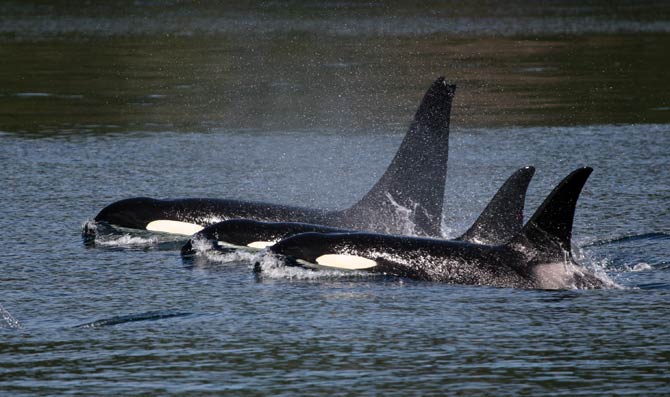
Orca, killer whale – interesting facts
- A herd of killer whales have been observed attacking an adult blue whale.
- The plowing can travel up to 150 kilometers a day.
- Plowing teeth are 10 centimeters long, with a diameter of up to 5 centimeters.
- These marine mammals can travel at speeds of up to 60 km / h.
- Already at birth, the killer whale weighs almost 200 kilograms and is more than 2 meters long.
- A killer whale can dive to a depth of 1,000 meters, staying underwater for more than 20 minutes.
- The killer whale can reach the age of 100.
